- Home
- About
- Map
- Trips
- Bringing Boat West
- Migration West
- Solo Motorcycle Ride
- Final Family XC Trip
- Colorado Rockies
- Graduates' XC Trip
- Yosemite & Nevada
- Colorado & Utah
- Best of Utah
- Southern Loop
- Pacific Northwest
- Northern Loop
- Los Angeles to NYC
- East Coast Trips
- Martha's Vineyard
- 1 Week in Quebec
- Southeast Coast
- NH Backpacking
- Martha's Vineyard
- Canadian Maritimes
- Ocracoke Island
- Edisto Island
- First Landing '02
- Hunting Island '02
- Stowe in Winter
- Hunting Island '01
- Lake Placid
- Chesapeake
- Provincetown
- Hunting Island '00
- Acadia in Winter
- Boston Suburbs
- Niagara Falls
- First Landing '99
- Cape Hatteras
- West Coast Trips
- Burning Man
- Utah Off-Roading
- Maui
- Mojave 4WD Course
- Colorado River Rafting
- Bishop & Death Valley
- Kauai
- Yosemite Fall
- Utah Off-Road
- Lost Coast
- Yosemite Valley
- Arizona and New Mexico
- Pescadero & Capitola
- Bishop & Death Valley
- San Diego, Anza Borrego, Joshua Tree
- Carmel
- Death Valley in Fall
- Yosemite in the Fall
- Pacific Northwest
- Utah Off-Roading
- Southern CA Deserts
- Yosemite & Covid
- Lake Powell Covid
- Eastern Sierra & Covid
- Bishop & Death Valley
- Central & SE Oregon
- Mojave Road
- Eastern Sierra
- Trinity Alps
- Tuolumne Meadows
- Lake Powell Boating
- Eastern Sierra
- Yosemite Winter
- Hawaii
- 4WD Eastern Sierra
- 4WD Death Valley +
- Southern CA Deserts
- Christmas in Tahoe
- Yosemite & Pinnacles
- Totality
- Yosemite & Sierra
- Yosemite Christmas
- Yosemite, San Diego
- Yosemite & North CA
- Seattle to Sierra
- Southwest Deserts
- Yosemite & Sierra
- Pacific Northwest
- Yosemite & South CA
- Pacific Northwest
- Northern California
- Southern Alaska
- Vancouver Island
- International Trips
- Index
- Tips
- Books
- Photos/Videos
- Search
- Contact
Athens, Greece
Sunday, September 4, 2022 - 8:30am by Lolo
6776 miles and 22 hours from our last stop - 4 night stay
Travelogue
Day 1 - Arrival
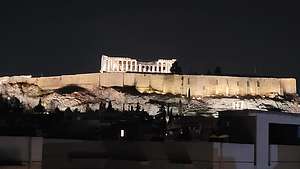 View of Acropolis from hotel rooftopWe left San Francisco on Saturday night at 9:00 and arrived at our Athens hotel around midnight on Sunday night. It felt like a whole day had just disappeared on us. That didn’t stop us, however, from taking the elevator up to the rooftop to catch our first glance of the Acropolis, lit up in the night.
View of Acropolis from hotel rooftopWe left San Francisco on Saturday night at 9:00 and arrived at our Athens hotel around midnight on Sunday night. It felt like a whole day had just disappeared on us. That didn’t stop us, however, from taking the elevator up to the rooftop to catch our first glance of the Acropolis, lit up in the night.
Having accomplished that, we crawled into bed and managed to sleep for 8 hours, putting us somewhat in sync with Greek time.
Our 15-day Road Scholar tour didn’t start for another day and a half, so we would have some time to explore the city on our own. Our hotel, the Acropolis Select, was located right in the heart of things, so it was easy for us to walk everywhere.
Day 2 - Acropolis Loop, Mars Hill, Ancient Agora, and Anafiotika
.thumbnail.jpg) Odeon of of Herodes AtticusAfter a hearty breakfast at the hotel buffet, we set off on a walk to get the lay of the land with the goal of doing the Acropolis Loop, a pedestrian walkway which, as its name implies, loops around the Acropolis. We would not enter the Acropolis today, as we would be doing that with our Road Scholar group in a few days. The crowds were a bit overwhelming.
Odeon of of Herodes AtticusAfter a hearty breakfast at the hotel buffet, we set off on a walk to get the lay of the land with the goal of doing the Acropolis Loop, a pedestrian walkway which, as its name implies, loops around the Acropolis. We would not enter the Acropolis today, as we would be doing that with our Road Scholar group in a few days. The crowds were a bit overwhelming.
From our hotel it was just a short distance to Dionysiou Areopagitou, the pedestrian boulevard that traces the southern edge of the Acropolis grounds. There were already big lines to get into the Acropolis, but the cobblestone walkway was still relatively quiet, as it was still fairly early in the morning.
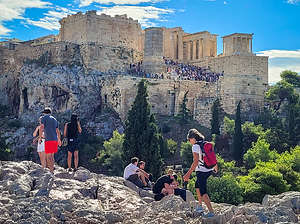 Lolo climbing the slippery marble of Mars HillWe passed the Odeon (theater) of Herodes Atticus, a large 5,000-seat amphitheater, built into the southwestern slope of the Acropolis. Built by the Romans in 161 AD, it is still used today for performances. However, it was renovated to its current condition in the 1950s. I so badly wanted to get tickets for a performance, but there just wasn’t time in our busy tour schedule.
Lolo climbing the slippery marble of Mars HillWe passed the Odeon (theater) of Herodes Atticus, a large 5,000-seat amphitheater, built into the southwestern slope of the Acropolis. Built by the Romans in 161 AD, it is still used today for performances. However, it was renovated to its current condition in the 1950s. I so badly wanted to get tickets for a performance, but there just wasn’t time in our busy tour schedule.
We took a side trip from the Dionysiou Areopagitou to Mars Hill (Areopagus), the knobby, windswept hill near the western entrance to the Acropolis with great views of the Acropolis. Climbing to the top of this small hill was pretty precarious in that the stone stairs and the rocks on top are so slippery, polished smooth by the crowds of people that walk on them each day. They actually shined. Despite being rock climbers and comfortable with scrambling on rocks, I found myself slipping and even scooching along on my butt to keep from falling.
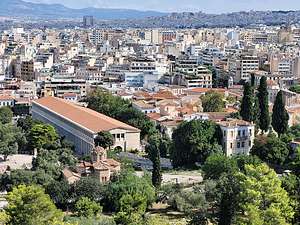 View of Ancient Agora from Mars HillWhen I got to a point where people couldn’t obstruct my view of the Acropolis, I plopped myself down and just took in the view.
View of Ancient Agora from Mars HillWhen I got to a point where people couldn’t obstruct my view of the Acropolis, I plopped myself down and just took in the view.
Besides having a great view of the Acropolis, which looked like it was being overrun by an army of tourists, there was a more serene view of the Ancient Agora below to the north. We would visit that further along on our walk later.
Once safely down from Mars Hill, we continue along Dionysiou Areopagitou boulevard, eventually making a right onto the quiet Apostolou Pavlou, also a pedestrian walkway, which traces the western edge of the Acropolis grounds.
This part of the Acropolis Loop was much quieter, enough so to allow a turtle to navigate its way along without being crushed by Segways.
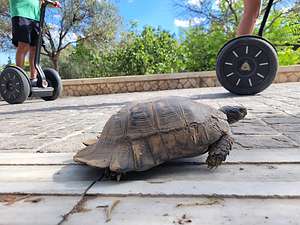 Slow traffic along the Acropolis LoopEventually we came to Thissio, a trendy neighborhood with tons of cafes and restaurants, many of which had Acropolis views.
Slow traffic along the Acropolis LoopEventually we came to Thissio, a trendy neighborhood with tons of cafes and restaurants, many of which had Acropolis views.
We continued on turning east on Adrianou, which brought us to the entrance of the Ancient Agora. Since this was not part of our Roads Scholar tour, we decided to visit it on our own, with a little help from a Rick Steves audio tour which we had downloaded before leaving home.
While the Acropolis is the main show in current day Athens, it was the Agora (which means “gathering place") that was the real heart of ancient Athens. From 600 BCE to 300 AD. It was the place where ancient Greeks, and eventually the conquering Romans, came to shop, conduct business, pass laws, talk philosophy, and attend plays.
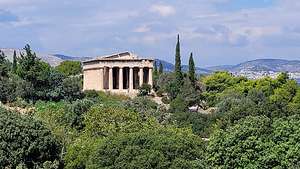 Temple of Hephaestus in the Ancient AgoraWe paid our 8 euros each and entered what are mostly the ruins of the Agora. Little survives from its height, except for the Temple of Hephaestus and a stoa that was reconstructed in 1952. Compared to the Acropolis, it was pleasantly quiet so we could wander around at our leisure while Rick Steves talked in our ears. We weren’t the only ones.
Temple of Hephaestus in the Ancient AgoraWe paid our 8 euros each and entered what are mostly the ruins of the Agora. Little survives from its height, except for the Temple of Hephaestus and a stoa that was reconstructed in 1952. Compared to the Acropolis, it was pleasantly quiet so we could wander around at our leisure while Rick Steves talked in our ears. We weren’t the only ones.
From the main gate, we strolled along the Panathenaic Way, the city’s main street, which led through the main square and up to the Acropolis. During Ancient Greek times, a Panathenaic Festival was held each summer, in which the birthday of Athena, the patron goddess of Athens, was celebrated.
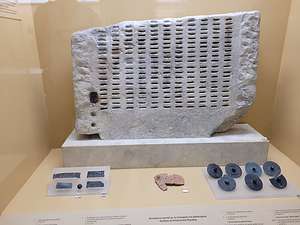 A kleroterion, ancient voting machine in the Agora MuseumThousands of people would parade along the Way, dancing and banging tambourines. The main “float” carried the peplos, a ceremonial robe woven as a gift for Athena, which was placed on a life-size old wooden statue of Athena Polias (“Guardian of the City”) in the Erechtheum.
A kleroterion, ancient voting machine in the Agora MuseumThousands of people would parade along the Way, dancing and banging tambourines. The main “float” carried the peplos, a ceremonial robe woven as a gift for Athena, which was placed on a life-size old wooden statue of Athena Polias (“Guardian of the City”) in the Erechtheum.
We turned left to the reconstructed Stoa, a two-story high 400-foot long rectangular building with covered walkways, lined with 45 Doric columns on the outside and 22 Ionic columns in the interior (the 2x + 1 formular for columns that we would later see at the Parthenon. While once serving as a sort of shopping mall, the old stalls currently house the very interesting Agora Museum with artifacts laid out in chronological order.
One of the most interesting artifacts on display was an early voting machine called a kleroterion, a slab of stone incised with rows of slots and an attached tube. It was used to randomly select citizens to serve on the city council. In this way, each citizen would get a chance to serve (sort of like jury duty). Perhaps, the ancient Greeks had a better idea than our modern system.
.thumbnail.JPG)
After leaving the Agora, we continued walking along Adrianou east and then south, in search of Anafiotika, a tiny, hard-to-find neighborhood of winding, narrow alleyways with tiny homes clinging to the hillside surrounding the Acropolis.
It was built by people from the tiny Cycladic island of Anafi, who came to Athens looking for work after Greece gained its independence from the Ottomans in 1821. Some descendants of the original islanders still live here in what they call Anafiotika (“little Anafi”).
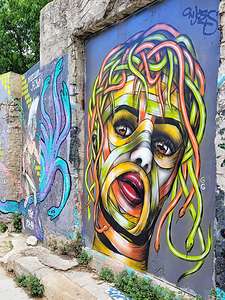 Street Art in AnafiotikaIt was so much fun randomly wandering and getting lost in its labyrinth of narrow alleyways with cute houses, lots of colorful flowers, innumerable cats, and interesting street art. Plus, the best part was that we had left the crowds around the Acropolis behind and pretty much had this place to ourselves.
Street Art in AnafiotikaIt was so much fun randomly wandering and getting lost in its labyrinth of narrow alleyways with cute houses, lots of colorful flowers, innumerable cats, and interesting street art. Plus, the best part was that we had left the crowds around the Acropolis behind and pretty much had this place to ourselves.
Every once in a while we would come to the end of a lane and be confronted with an amazing view of the modern city of Athens laid out before us, with the cone-shaped Lycabettus Hill, the largest of the seven hills in Athens, looming over it.
We stopped for lunch at the Anafiotika Cafe where Herb had his first (of many) pastitsio, a Greek version of lasagna, with a white creamy sauce rather than marinara and a hint of cinnamon.
At this point, we were really jet lagged and exhausted, so we headed back to the Acropolis Select for a well-need nap.
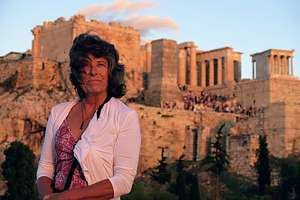
So off we marched again (mind you, this is still day 1) to the Dionysiou Areopagitou pedestrian boulevard and on to the side trip up Mars Hill. This time I had sandals on rather than sneakers, so the climb up was even more precarious than before.
It was worth every bit though, as we watched the sun do its magic and light the Acropolis in a golden glow.
This day wasn’t over yet. There was still dinner to deal with, so we walked back to the Anafiotika neighborhood again and had pizza and wine at the Anafiotika rooftop restaurant.
I think that was probably more than enough for our first full day in Athens.
Day 3 - Hike up Lycabettus Hill and Evening Meetup with Road Scholar group
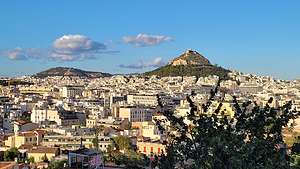 View of Lycabettus Hill from AnafiotikaTonight at 6:00 we would be meeting our Road Scholar guide and group for a welcome drink and introductions. That meant we had most of the day to ourselves to explore more of Athens.
View of Lycabettus Hill from AnafiotikaTonight at 6:00 we would be meeting our Road Scholar guide and group for a welcome drink and introductions. That meant we had most of the day to ourselves to explore more of Athens.
We had explored much of the area around the Acropolis, except for actually going in, which we would do tomorrow, so I was struggling to think of something interesting to do. Then, during the middle of the night it came to me like a vision - that mountain with the little white church on top that seemed to be visible from everywhere was calling to me.
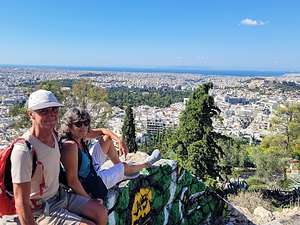 Making our way up Lycabettus HillAfter further research, I found out that it was Lycabettus Hill, the highest of the seven hills in Athens - almost twice as high as the Acropolis Hill. So we set off from our hotel, walked through the trendy neighborhood of Plaka, which we would explore more later, and continued through the modern downtown area until we got to the base of Lycabettus Hill.
Making our way up Lycabettus HillAfter further research, I found out that it was Lycabettus Hill, the highest of the seven hills in Athens - almost twice as high as the Acropolis Hill. So we set off from our hotel, walked through the trendy neighborhood of Plaka, which we would explore more later, and continued through the modern downtown area until we got to the base of Lycabettus Hill.
We never did see the cable car to the top, but no matter, because we wanted to walk the winding switchbacks up to the summit anyway. Despite being the tallest of the city’s hills, it was still only a modest 909 feet high, a far cry from the elevation gains we were used to in the American West.
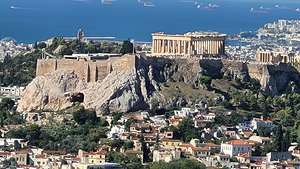 View of the Acropolis from top of Lycabettus HillAt the top is the tiny 19th century Agios Georios (the Chapel of St. George), which was unfortunately closed. However, the viewing platform surrounding it provided us with awesome 360 degree views of the whole of Athens, including the Acropolis, the Aegean Sea, and the mountains of the Peloponnese.
View of the Acropolis from top of Lycabettus HillAt the top is the tiny 19th century Agios Georios (the Chapel of St. George), which was unfortunately closed. However, the viewing platform surrounding it provided us with awesome 360 degree views of the whole of Athens, including the Acropolis, the Aegean Sea, and the mountains of the Peloponnese.
All in all the hike from the hotel to the summit and back was about 6 miles with 1,000 foot elevation gain.
Our Road Scholar tour hadn’t even begun yet, but we had already explored most of Athens’ neighborhoods.
.thumbnail.jpg) Relaxing at the hotel rooftop barTime for lunch, a shower and a nap, before meeting with our guide and fellow “scholars,” whom we would be spending the next two weeks with. I admit to being a little nervous. Herb and I are so used to just the two of us traveling together that we were a bit apprehensive as to how we would like the “group” thing.
Relaxing at the hotel rooftop barTime for lunch, a shower and a nap, before meeting with our guide and fellow “scholars,” whom we would be spending the next two weeks with. I admit to being a little nervous. Herb and I are so used to just the two of us traveling together that we were a bit apprehensive as to how we would like the “group” thing.
I felt a little like a new kid in school meeting my classmates for the first time. Would they be nice? Would we make friends? Although I didn’t think so at the time, we became a completely cohesive group (or functional as Tassos, our tour guide said) that within a few days we felt like we had known each other forever. So many bright, interesting people, and so many laughs.
Plus, we really lucked out with our guide, Tassos, an ex-archaeologist with a passionate love for the history, art, and culture of his country, who over the next two weeks would help us totally immerse ourselves in the lives (from Bronze Age to current day) of the people of Greece.
After introductions, we moved up to the hotel rooftop for a lovely dinner overlooking the Acropolis, which we would be visiting as a group the next day.
Day 4 - Acropolis Museum and the actual Acropolis
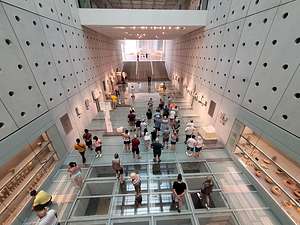 Acropolis MuseumThe next morning after our very ample hotel buffet breakfast, our group gathered in the hotel lobby to begin our short, ¼-mile trek to the Acropolis Museum. Tassos felt that a visit to the museum first, would amplify our experience of the actual Acropolis.
Acropolis MuseumThe next morning after our very ample hotel buffet breakfast, our group gathered in the hotel lobby to begin our short, ¼-mile trek to the Acropolis Museum. Tassos felt that a visit to the museum first, would amplify our experience of the actual Acropolis.
The Acropolis Museum is considered one of the finest museums in the world. Unlike other museums that display works of art from around the world, the Acropolis Museum houses artifacts from just one place - the Acropolis, which looms over it from atop the hill above. It is specifically designed to complete the experience of visiting the actual Acropolis.
Surprisingly, the museum iis an eye-catching, glassy postmodern building - sort of a modern temple to house a treasure of ancient artifacts from 3000 years ago. Actually, make that 6000 years ago, because the museum was built above a neighborhood from 4000 BCE, whose streets, houses, baths, and workshops were visible through the glass floors below your feet as you enter the main building.
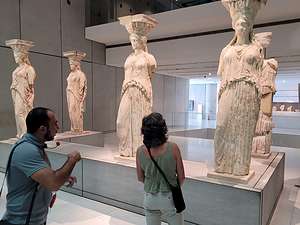 Acropolis Museum - 5 of the original CaryatidsAfter entering the museum, we ascended a ramp meant to represent the experience of ancient Greeks ascending the Sacred Rock of the Acropolis. More glass floors beneath us revealed artifacts and details of everyday life from the ancient neighborhood found while constructing the museum.
Acropolis Museum - 5 of the original CaryatidsAfter entering the museum, we ascended a ramp meant to represent the experience of ancient Greeks ascending the Sacred Rock of the Acropolis. More glass floors beneath us revealed artifacts and details of everyday life from the ancient neighborhood found while constructing the museum.
Moving on to the first floor, we came face to face with the Kore and Kouros of the Archaic period (7th century BC to the end of the Persian Wars in 479 BC).
Eventually we came to my favorites - the Caryatids that once held up the porch of the Erechtheion. Five out of six of the originals were here. There was an empty circle left for the Caryatid taken by Lord Elgin (along with nearly half the 150m marble frieze around the Parthenon) and sold to the British Museum in the early 19th century. The Greeks want their treasures back, but this controversy has been going on for two centuries and probably will go on for two more.
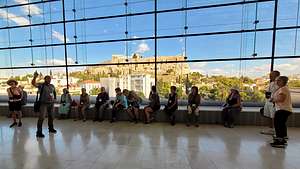 View of Acropolis from Acropolis MuseumThe six on the actual Acropolis are copies, removed to protect them from erosion. I never realized before that each of them is unique.
View of Acropolis from Acropolis MuseumThe six on the actual Acropolis are copies, removed to protect them from erosion. I never realized before that each of them is unique.
The escalators up to the third floor deposited us inside a virtual Parthenon, featuring the collection of Parthenon structures, laid out the way they were on the original Parthenon. Even the floor was 228 feet long and 101 feet wide, just like the real Pathenon, which we could see through the large glass windows surrounding the exhibits. Even the stainless-steel columns marked the location of each marble column on the real Parthenon.
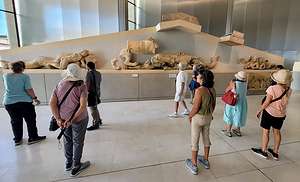 Remains of a pediment from the ParthenonThis floor, which is totally dedicated to the Parthenon’s metopes, frieze and pediments, is the highlight of the Acropolis Museum. We walked around the frieze, where there are some original models as well as replicas of those taken (by Lord Elgin) or destroyed. All the while, we could see the real thing through the huge glass windows that wrapped around the entire floor.
Remains of a pediment from the ParthenonThis floor, which is totally dedicated to the Parthenon’s metopes, frieze and pediments, is the highlight of the Acropolis Museum. We walked around the frieze, where there are some original models as well as replicas of those taken (by Lord Elgin) or destroyed. All the while, we could see the real thing through the huge glass windows that wrapped around the entire floor.
Now, it was time to see the real thing.
The Acropolis has been the heart and soul of Athens for millenia, and many temples have graced its hill. What we would see today was the rebuilding in 450 BCE, when the Athenians, fresh from their victory over the Persians, decided to rebuild the destroyed buildings on a grand scale.
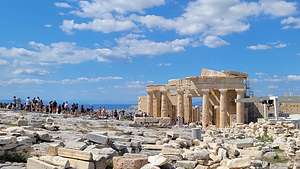 The Propylaea (entrance gate to the Acropolis)Pericles, Athens’ leader at the time, funneled Athens' newfound wealth from donations by allies in the Delian League into a massive rebuilding program, led by the visionary architect/sculptor Pheidias. The result is an incredible 4-building ensemble: the Propylaea (entrance gate), Parthenon, Erechtheion, and Temple of Athena Nike.
The Propylaea (entrance gate to the Acropolis)Pericles, Athens’ leader at the time, funneled Athens' newfound wealth from donations by allies in the Delian League into a massive rebuilding program, led by the visionary architect/sculptor Pheidias. The result is an incredible 4-building ensemble: the Propylaea (entrance gate), Parthenon, Erechtheion, and Temple of Athena Nike.
After entering the grounds, we (and crowds and crowds of others) proceeded up the steps of the Propylaea, the magnificent Classical Greek Doric building complex that served as the monumental ceremonial gateway to the Acropolis. It was designed by
Mnesicles, who brilliantly found a solution to the difficult problem of building a monumental structure on varying levels of terrain.
 (1).thumbnail.jpg) Long side of the ParthenonThe Propylaea is U-shaped, with a large central hallway (the six Doric columns), which looks a bit like a mini Parthenon, flanked by two side wings. The left wing, called the Pinakotheke (“painting gallery”) once contained artwork and housed visiting dignitaries.
Long side of the ParthenonThe Propylaea is U-shaped, with a large central hallway (the six Doric columns), which looks a bit like a mini Parthenon, flanked by two side wings. The left wing, called the Pinakotheke (“painting gallery”) once contained artwork and housed visiting dignitaries.
Unfortunately, there were so many people that we felt a bit like we were being herded like cattle.
As we continued toward the Parthenon, we heard a security guard start whistling and waving to stop a girl draped in a Greek flag posing before the temple. We learned later that posing before their sacred treasures is considered disrespectful in Greece. However, there were not enough security guards to stop the dozens of high-heeled, brightly dressed Instagram “influencers” from doing their thing.
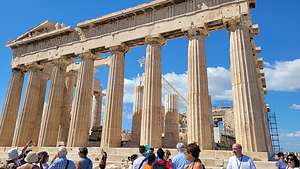 Back of the ParthenonThe star attraction of the Acropolis is the Parhenon, a marble temple dedicated to the Greek goddess Athena. It was built between 447 and 432 BC during the height of the ancient Greece empire. It is the largest Doric temple in ancient Greece - 228 feet long and 101 feet wide. At each of its two ends there are 8 fluted Doric columns and 17 on each of its sides.The Greeks were into harmony and numbers, so the ratio of columns in all Greek temples is 2x + 1.
Back of the ParthenonThe star attraction of the Acropolis is the Parhenon, a marble temple dedicated to the Greek goddess Athena. It was built between 447 and 432 BC during the height of the ancient Greece empire. It is the largest Doric temple in ancient Greece - 228 feet long and 101 feet wide. At each of its two ends there are 8 fluted Doric columns and 17 on each of its sides.The Greeks were into harmony and numbers, so the ratio of columns in all Greek temples is 2x + 1.
The Parthenon has gone through many phases. First, as the Classical temple built by Pericles in the 5th century BCE. Then in the 5th century AD, it became a Christian church. During this period, the pagan sculptures and decoration were removed and the interior was decorated with colorful Christian frescoes.
.thumbnail.jpg) The ErechtheionThen in 1456, the Ottoman Turks took over and converted it into a mosque, even adding a minaret. An unfortunate incident occurred in 1687, during the Venetian siege of the Acropolis. The defending Turks were using the Parthenon to store gunpowder so when the Venetians hit it with a mortar shell, it caused an explosion that blew out the heart of the building, destroying the roof and parts of the walls and colonnade.
The ErechtheionThen in 1456, the Ottoman Turks took over and converted it into a mosque, even adding a minaret. An unfortunate incident occurred in 1687, during the Venetian siege of the Acropolis. The defending Turks were using the Parthenon to store gunpowder so when the Venetians hit it with a mortar shell, it caused an explosion that blew out the heart of the building, destroying the roof and parts of the walls and colonnade.
In 1801, Lord Elgin, the British ambassador to the Ottomans, got permission from the sultan to take sculptures from the Parthenon. He even sawed some of them off the building. Then he carted them off to London where they were placed in the British Museum, where they still remain - a bit of a sticking point with the Greeks.
.thumbnail.jpg) Porch of the CaryatidsThere are still a few original frieze, metope, and pediment carvings on the Parthenon, but most of them are either in the British Museum or the nearby Acropolis Museum where we had just seen them.
Porch of the CaryatidsThere are still a few original frieze, metope, and pediment carvings on the Parthenon, but most of them are either in the British Museum or the nearby Acropolis Museum where we had just seen them.
From our vantage point atop the Acropolis, we had a great view of Lycabettus Hill, the mountain we had climbed yesterday.
Near the Parthenon, stood the Erechtheion, a temple almost as prestigious as the Parthenon in its day. Its primary function was to house the ancient wooden cult status of Athena - the one that would receive a new woolen peplos each year at the end of the Panathenaic Festival.
The temple’s most famous feature, and my personal favorite, is the Porch of the Caryatids, where for over 2,500 years, these lovely ladies have been supporting the roof. If you look closely, each of them is unique. Their legs serve as columns, the pleated robes the fluting, the fruit baskets on top of their heads as capitals, and their hair as buttresses. As I mentioned earlier, these are reproductions. Lord Elgin ran away with one of them, and the other five are in the Acropolis Museum.
.thumbnail.JPG)
Despite its proximity to the more hidden and less well-known Anafiotika neighborhood, whose narrow alleyways we had explored the night before, the Plaka had a very different vibe, with high-end shops, sidewalk cafes, and family-run tavernas. This was modern, trendy Athens, while Anafiotika was still living in a bygone day.
When we got back to the hotel, we were pretty pooped, and tomorrow we would have to get up at 5:30 to catch a very early 5 ½ hour ferry to Mykonos, our first Greek Island. So, we stopped at a grocery store to buy some cheese and crackers and a bottle of wine to enjoy on our balcony.
- 1 of 6
- next ›
Athens location map in "high definition"
Javascript is required to view this map.
